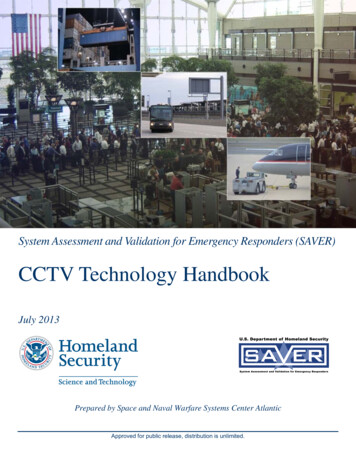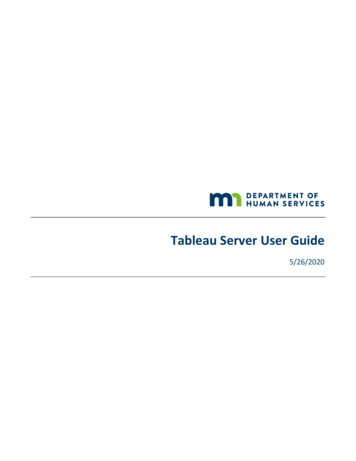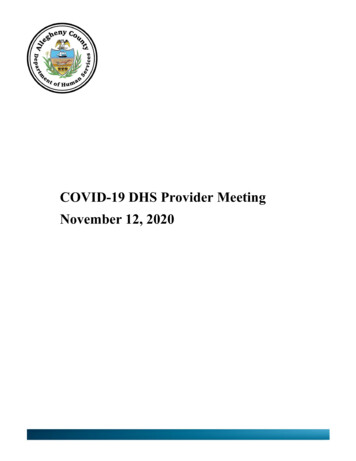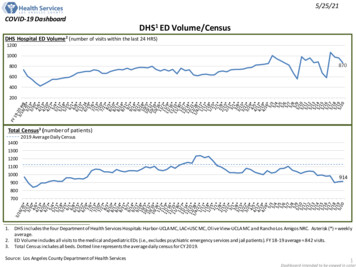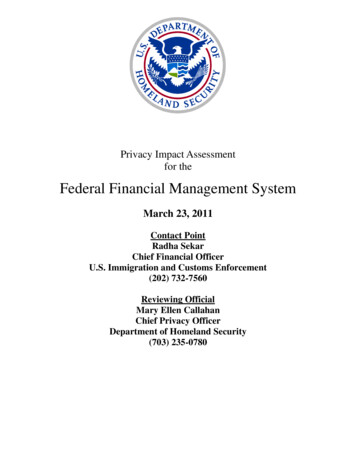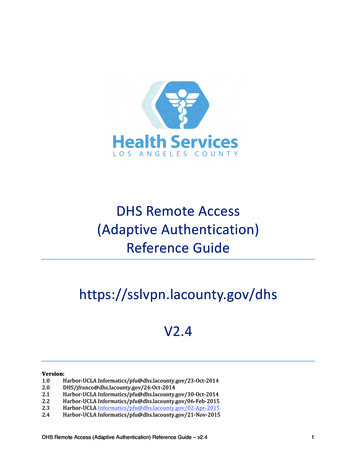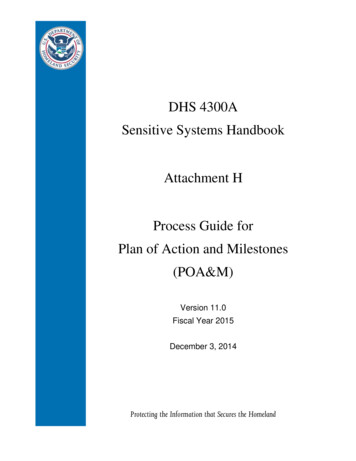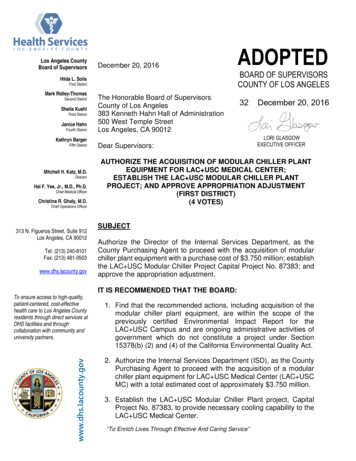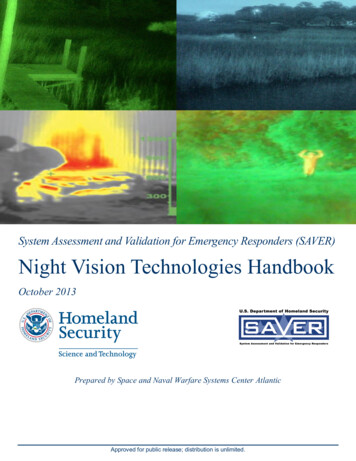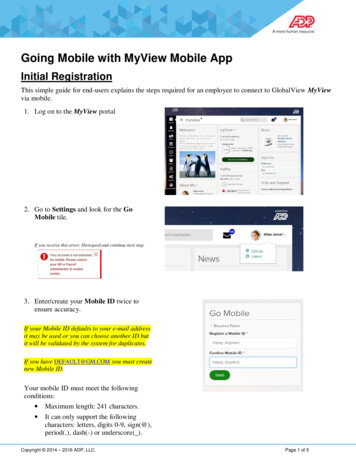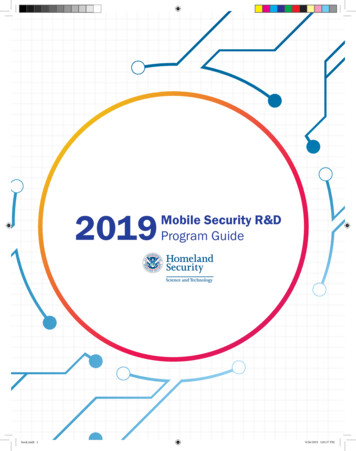
Transcription
2019book.indd 1Mobile Security R&DProgram Guide9/26/2019 1:03:37 PM
book.indd 29/26/2019 1:03:37 PM
The Department of Homeland Security Science and Technology Directorate is committed to providingaccess to our web pages and documents for individuals with disabilities, both members of the public andfederal employees. If the format of any elements or content within this document interferes with yourability to access the information, as defined in the Rehabilitation Act, please email the Program Manager,Vincent.Sritapan@hq.dhs.gov and Jeffrey.Myers@associates.hq.dhs.gov. You will receive a responsewithin 2 business days. To enable us to respond in a manner most helpful to you, please indicate thenature of your accessibility problem, the preferred format in which to receive the material, the webaddress (URL) or name of the document of the material with which you are having difficulty, and yourcontact information.
IntroductionThank you for your interest in the U.S. Department of Homeland Security (DHS) Science andTechnology Directorate’s (S&T) Mobile Security Research and Development (R&D) program. Thistechnology guide introduces you to the goals and objectives for the program, as well as its alignmentwith DHS and federal mobile security strategies and priorities. It also provides a view into S&T’sdevelopment of new and cutting-edge mobile security solutions.This technology guide, which will be updated and published periodically, features nine new andinnovative technologies. Again, it is our pleasure to introduce you to the Mobile Security R&Dprogram and its newly developed and enhanced technologies. We are excited to share thesepromising mobile security technologies with you and welcome your feedback.Through targeted R&D addressing mobile security gaps and barriers, DHS S&T helps accelerategovernment and mobile industry adoption of secure mobile technologies and protect the HomelandSecurity Enterprise (HSE). This guide represents important contributions of the overall program’sMobile Application Security (MAS) and Mobile Device Security (MDS) projects in supporting DHScomponent requirements, as well as broader federal government and HSE mobile security needs.The Mobile Security R&D program goals are to apply R&D to: Enable the mobile workforce to support the homeland security mission; andEnable mission success through effective, efficient and secure mobile technologies.Going forward, the Mobile Security R&D program will be tightly aligned to new requirements put forthby the DHS Cybersecurity and Infrastructure Agency.Sincerely,Mary McGinleyDivision DirectorPhysical & Cybersecurity DivisionScience & Technology DirectorateDepartment of Homeland SecurityEmail: mary.c.mcginley@hq.dhs.govbook.indd 3Vincent SritapanProgram ManagerOffice of Mission & Capability SupportScience & Technology DirectorateDepartment of Homeland SecurityEmail: Vincent.Sritapan@hq.dhs.gov9/26/2019 1:03:37 PM
CONTENTSbook.indd 406MOBILE SECURITY R&D PROGRAM STRATEGY14MOBILE APPLICATION SECURITY15Orchestration Platform and Correlation forMobile Software Assurance Tools16Assured Mobile Application Lifecycle Using Red Hat Mobile17Advancing Mobile Endpoint Security18Android Security Toolkit19Hardware-Anchored Continuous Validationand Threat Protection of Mobile Applications20MOBILE DEVICE SECURITY21Virtual Mobile Infrastructure22Scalable Analysis of Android& iOS Firmware (SAFARI)23SENsor Secure Enterprise Infrastructure24Firmware Automated Analysisat Scale with Testing (FAAST)25MOBILE SECURITY GUIDANCE26TABLE OF MOBILE SECURITY GUIDANCE36CONCLUSION9/26/2019 1:03:37 PM
Mobile R&DProgram Strategybook.indd 59/26/2019 1:03:37 PM
Mobile Security Research and Development Program StrategyVisionThe Federal government workforce has become increasingly reliant on mobile technologies to facilitate itsmission and elevate productivity. As use of mobile technologies becomes more pervasive in thegovernment, solutions are needed to secure mobile devices, for a coordinated approach to lifecyclemanagement, and policies to guide the selection and operational use of mobile solutions. To promote theadoption of safe and secure mobile technology within the Department of Homeland Security (DHS) andacross the entirety of the Federal government, the DHS Science & Technology Directorate (S&T) hasestablished the Mobile Security Research and Development (R&D) program. Presently, this program iscomposed of the Mobile Device Security (MDS) and the Mobile Application Security (MAS) projects. DHSalso has identified a need for a new R&D project focused on security and resilience of mobile networkinfrastructure. S&T currently is developing requirements for this new program area.GUIDING VISION FOR MOBILE SECURITY R&DAccelerate the adoption of secure mobile technologies by theDepartment, the Federal government, and the global community.BackgroundThe government’s increasing reliance on mobile technology has made it an attractive and lucrativetarget for cyberattacks. The enhanced capabilities mobile technologies provide, the ubiquity and diversityof mobile applications and devices, and the typical use of the devices outside agencies’ traditional networkboundaries requires a security approach that differs substantially from the protections developed fordesktop workstations.The following statistics tell the scope and scale of the mobile industry: 5 billion subscribers globally[1], 395.9 million subscribers in the U.S.[2], and 1.5 millionsubscribers within the federal government. Wireless revenues: 1.06 trillion globally[1], 235.6 billion in the U.S.[2] and almost 1 million infederal mobile and wireless services contracts. 77 percent of U.S. adults own and use smartphones[3] and almost 40 percent of DHS employeeshave government-issued mobile devices.[4] The official mobile app stores (Google Play[5], Apple App Store[6], Amazon Appstore[7]) collectivelyoffer nearly 7 million unique mobile apps. More than 1.5 million app publishers/developers provide apps to official app stores.[8]Two converging factors help to create the urgent need for secure enterprise solutions. First, mobile solutionuse is rapidly increasing across the Federal government. Second, mobile threats are increasingly commonand more sophisticated, which puts data stored or processed on these devices at risk and exposesbackend systems and networks to attacks via mobile malware.As documented in the DHS Study on Mobile Device Security[9], threats exist across all elements of themobile ecosystem--from mobile devices, applications and data to the underlying infrastructure of carriernetworks, mobile operating system providers, mobile device vendors, and enterprise systems andinfrastructure. As shown in Figure 1, a mature mobile ecosystem comprises many elements. In addition tothe mobile device, it includes the environment that connects the device06to other devices, mobile applications, mobile applicationmarketplaces and information systems. Each area presentssecurity challenges and opportunities for additional studyand mobile security R&D.Mobile R&DProgram Strategybook.indd 69/26/2019 1:03:37 PM
ObjectivesTo respond to the evolving threats and security challenges with mobile technologies, S&T has establishedan approach for the Mobile Security R&D program to identify and meet customer-driven needs. Generally,the approach starts with requirements validated through S&T based on customer prioritization. Validatedrequirements are further refined to generate targeted R&D efforts. After a competitive acquisitionprocess, innovative technologies to meet the requirements are researched, developed and made availableto customers for pilots and refinement. In parallel, the Mobile Security R&D program maintains landscapeawareness of technical trends as well as policy and procurement issues to ensure integration needs areunderstood and mechanisms are in place after the R&D phase ends that enables customers to acquirethe new technologies and policies are in place to support operational use. The Mobile Security R&Dprogram follows a three-pronged approach to achieve its R&D vision:1.2.3.Partner with the DHS Cybersecurity and Infrastructure Agency (CISA), other DHS components andfederal stakeholders to identify operational requirements and capability gapsDevelop secure, innovative mobile solutions to support DHS CISA, then other Federal governmentmissions as coordinated through the Federal Mobility Group (FMG)Champion the solutions to support transition into operational use07Mobile R&DProgram Strategybook.indd 79/26/2019 1:03:38 PM
Strategic AlignmentWith the Mobile Security R&D program residing in S&T’s Physical and Cyber Security (PCS) Cyber portfolio,the primary customer alignment begins with DHS CISA, however, support will continue for requirementsdeveloped in coordination with stakeholders across the Federal government. Within DHS in particular, theMobile Security R&D program has sought to acquire technologies and capabilities identified by the DHSIntegrated Product Team (IPT), Secure Cyberspace–Mobile Security Sub-IPT. Broader alignment to DHSS&T priorities is as follows: Study on Mobile Device Security, April 2017[9]S&T Strategic Plan 2015-2019[10], Visionary Goal, Objectives 1 and 2:Objective 1: Deliver Force Solutions:Identify and Prioritize Operational Requirements and Capability GapsMake Strategic Investments in High-Impact, Priority AreasPartner with the Homeland Security Enterprise (HSE)Objective 2: Energize the Homeland Security Industrial Base (HSIB):Optimize Markets by Pooling Demand and Developing StandardsEngage the HSIB through a Deliberate, Continuous and Transparent ApproachImprove Programs Designed to Increase Collaboration with Innovative CompaniesDHS Information Technology Strategic Plan 2015-2018[11]:Goal 2: Innovative Technology, Objective 2.4: Enable end-to-end delivery of mobile solutions thatenhance enterprise-wide mobile computing capabilities for successful mission outcomes.Goal 4. Cybersecurity, Objective 4.2: Enable secure communications to effectively support themission of DHS and its partners.National Security Telecommunications Advisory Committee (NSTAC) Report to the President onEmerging Technologies Strategic Vision-DRAFT[12]:Security of the Fifth Generation (5G) infrastructure should receive great priority and the shift to 5Grepresents another opportunity to get cybersecurity right.Initiatives to Address Program ObjectivesOBJECTIVE 1. Partner with Components and Federal Stakeholders to Identify OperationalRequirements and Capability GapsThe Mobile Security R&D Program leverages the efforts of existing federal and DHS mobility workinggroups to gather and prioritize remediation of mobile security capability gaps that prevent implementationof mobile technologies at the federal level and across the HSE. These groups include the following federaland DHS working groups: DHS Integrated Product Team (IPT), Secure Cyberspace–Mobile Security Sub-IPT Federal Chief Information Officers (CIO) Council’s Information Security and Identity ManagementCommittee (ISIMC) Mobile Technology Tiger Team (MTTT) Mobile Services Category Team (MSCT) DHS Joint Requirements Council (JRC)OBJECTIVE 2: Develop Secure Mobile Solutions to Support the DHS MissionThe Mobile Security R&D program funds a number of solution development initiatives with private industryand academia to address gaps in mobile security technology and policy as identified through its08Mobile R&DProgram Strategybook.indd 89/26/2019 1:03:38 PM
partnerships with other DHS components and federal agencies (under Objective 1). These R&D efforts areapplied across the mobile ecosystem depicted in Figure 1 and build on existing technologies. R&Dsolution development is acquired through myriad flexible acquisition mechanisms, including targeted BroadAgency Announcements (BAAs), the S&T Long-Range BAA, Small Business Innovation Research (SBIR)funding, and Other Agencies Technology Solutions (OATS) SBIRs. The current Mobile Security R&D projectefforts are organized into the following R&D project areas, which are described in detail below: MDS MASFigure 1 – T e Mobile EcosystemMobile Device Security (MDS) ProjectThe MDS R&D project focuses on securing mobile devices that can be used by adversaries to physicallytrack device owners, to access sensitive information, to negatively impact government services, and forother nefarious objectives. The MDS R&D project focuses on three high-priority gap topics: mobile devicemanagement, trust implementation for mobile executables, and firmware security. MDS funds initiatives inthe following R&D areas to address these gaps:Mobile Software Roots of Trust. This area seeks to develop tamper-evident modules—or “roots of trust”—that can be continuously measured and verified to produce a chain of cryptographically strong evidenceabout the state of the device. This approach verifies devices are in a protected state at power-on andcontinues to bootstrap trust to verify software (e.g., operating system, apps, security managementsoftware, etc.) before and during execution. This root of trust can be queried and measured to attest tothe state of the device to provide greater assurance to security mechanisms such as software verification,application and data isolation, and data protection, which are at the heart of security enforcementtechnologies such as mobile device management.09Mobile R&DProgram Strategybook.indd 99/26/2019 1:03:38 PM
Firmware Security.There are many risks to the mobile ecosystem that originate in the supply chain. Firmware design and thefirmware update process are known avenues of security risks. For example, there have been documentedcases where commercially available smartphones contain preloaded software that collects sensitive userdata and sends it overseas[13]. To address these risks, S&T has embarked on two projects that exploresupply-chain security risks of embedded functionality that accesses user information without obtaininguser consent or circumvent security controls.Virtual Mobile Infrastructure Extensions. Depending on security and regulatory requirements,infrastructure virtualization may provide security controls necessary to enable critical operations via mobiledevices. To facilitate customer operations where virtualization provides an essential separation of datafrom mobile devices, S&T is funding virtual mobile infrastructure technology development.Mobile Device Security Projects. The MDS project industry and academia R&D initiatives andperformers are: SAFARI: Scalable Analysis of Firmware for AndRoid and IOS, Kryptowire LLC Firmware Automated Analysis at Scale with Testing (FAAST), Red Balloon Security, Inc. Virtual Mobile Infrastructure, Intelligent Waves, LLCMobile App Security ProjectThe Mobile App Security Project is developing innovative approaches that extend beyond deployment of anapp to provide continuous assurance of mobile app security throughout an app’s lifecycle. The MAS projecthas two primary R&D foci. One focus is continuous monitoring, vetting and security assurance of mobileapps to safeguard against vulnerabilities and future threats. The second focus is establishing a securityframework and integrated development environments that will result in mobile app development platformsthat enable developers to transparently ensure security and functionality throughout the mobile applicationlifecycle. The MAS thrusts are expanded upon below.Continuous Validation and Threat Protection for Mobile Apps. The MAS project is funding efforts tomonitor device and app execution against the security criteria established by the Federal MobileApplication Security Vetting Working Group and currently maintained by the National Information AssurancePartnership (NIAP)[6]. MAS is also developing capabilities specific to the mobile device operatingenvironment that will respond to current known threats and vulnerabilities including the identification ofmalware and vulnerable code. This R&D entails developing the capability to anticipate and—ifneeded—respond to future threats and vulnerabilities while continuously monitoring a mobile device’ssecurity posture. These capabilities go beyond identifying malicious software to pinpoint undesirablebehavior that violates user-defined risk criteria. By providing a standard evaluation score and analysisreport that provides actionable information for decision-makers to remediate problems, this effort alsopromotes information sharing across components and federal agencies, potentially reducing cost andavoiding duplication of analysis efforts.Integrated Security Throughout the Mobile Application Lifecycle. The MAS project is funding R&D effortsto augment mobile app development tools with functionality that—transparently to the developer—incorporates secure mechanisms as mobile apps are developed. To make a more immediate impact,efforts in this area are building on existing mature mobile app development platforms to includerequirements that will ease government use.10Mobile R&DProgram Strategybook.indd 109/26/2019 1:03:38 PM
Mobile Application Security Projects. The MAS project has industry and academia initiatives that crossboth R&D thrust areas: Mobile App Security Orchestration Platform/Certification Tool, Apcerto Inc. A Framework for Assessing, Analyzing, and Archiving Mobile Applications, Kryptowire LLC Continuous Validation and Protection for Mobile Devices, Lookout Hardware-Anchored Continuous Validation and Threat Protection of Mobile Applications,Qualcomm Technologies Assured Mobile Application Lifecycle using Red Hat Mobile, Kryptowire LLC/Red Hat, Inc. Android Security Toolkit, Progeny Systems/Microsoft/XamarinOBJECTIVE 3. Champion Program-Developed Technology to Support Transition into Operational Use.Transitioning program-developed technology into operational use is a priority for and an integral part of theMobile Security R&D program. S&T engages stakeholders early to inform the research and identifycustomers that are willing to be involved. During and after research execution, the program conductsoutreach to educate and raise awareness of the innovative technologies it is developing. Outreachactivities include hosting technology showcases, engaging directly with federal CIOs, expediting solutionmatchmaking and facilitating pilot projects to accelerate adoption of technologies.Secure and Resilient Mobile Network Infrastructure (SRMNI)As described in the DHS Study on Mobile Device Security[10], threats to the mobile network infrastructureare real and will require R&D as well as evolving policies and strategies to manage risks to the security ofthe mobile ecosystem. To support the DHS mission, CISA and S&T have coordinated the release of a BAA todevelop new standards to improve the security and resilience of critical mobile communications networks.The BAA focuses on the following:Current and Legacy Protocol Security. This initiative would seek approaches and implementations toprotect U.S. government personnel and citizens from being tracked or their calls or text messages frombeing snooped or hijacked due to inherent vulnerabilities in Signaling System Seven (SS7) and Diameter,which are rogue cellular tower threats, or vulnerabilities in Cloud-Radio Access Network (RAN)virtualized infrastructure.5G Security. This project area will seek innovative approaches that leverage 5G virtual functions/networkslicing to define methods and approaches to achieve: Flexible 5G security architecture tailored for a government environment Government-controlled security policy End-to-end security for the mobile device to the core Approaches to implement interoperable secure unclassified voice across Federal governmentdepartments and agenciesMobile Network Traffic Visibility for the Enterprise. This R&D area will focus on development of new orenhanced approaches to increase visibility into mobile network traffic and to improve protection for mobiledev
established the Mobile Security Research and Development (R&D) program. Presently, this program is composed of the Mobile Device Security (MDS) and the Mobile Application Security (MAS) projects. DHS also has identified a need for a new R&D project focused on security and resilience of mobile network infrastructure.
